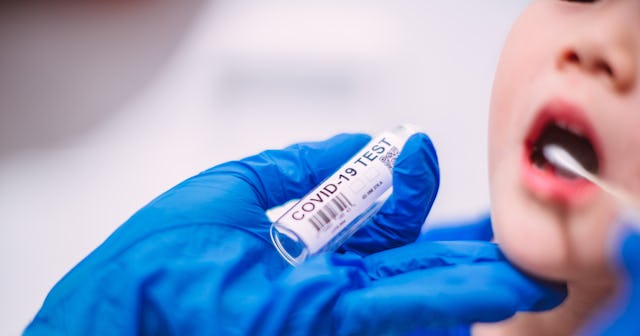2.5 Million Children Have Tested Positive For COVID-19 As Of Jan. 14

The hospitalization rate of children with COVID-19 has increased, too
The American Academy of Pediatrics reports that since the beginning of the pandemic, about 2.5 million children have tested positive for COVID-19. In startling news, 211,000 new child COVID-19 cases were reported last week, the highest-ever weekly increase during the pandemic.
The organization tallied the numbers of reported COVID-19 cases tracked on the health department websites of 49 states, New York, D.C., Puerto Rico, and Guam. Kids represented 12.6 percent of all patients in states reporting incidents by age. Some states announced hospitalizations and mortality by age; so far, the available statistics signal that COVID-19-associated hospitalization and death is unlikely in children.
In Arizona, the hospitalization rate has skyrocketed since October, during which 77 children hospitalized. Now, in January, that number is closer to 400 kids. Just. In. Arizona.
“Unfortunately, the message of ‘lower risk’ in children was misinterpreted as ‘no risk’ by many until several children were diagnosed with multisystem inflammatory syndrome in children,” Pinar Karaca-Mandic, professor of health care risk management and academic director of the Medical Industry Leadership Institute at the University of Minnesota Carlson School of management, told Healio.
“Testing among children has not been wide-scale and consistent to get a good understanding of prevalence of cases and infection rate among children,” Karaca-Mandic continued. “Our study shows that children can get sick and hospitalized, while most children, fortunately, have less severe symptoms.”
According to a January study published in JAMA Pediatrics titled “Trends in Pediatric Hospitalizations for Coronavirus Disease 2019,” the hospitalization rate of children with COVID-19 has experienced a more than eightfold increase over the course of six months.
“In our study, by Nov. 15, more than 17 children per 100,000 children had a COVID-19 hospitalization,” Karaca-Mandic said. “[The corresponding] cumulative hospitalization rate for adults was 282 per 100,000 adults. Parents, in particular, should understand the symptoms of COVID, know early signs of deterioration and monitor their children closely until they fully recover.”
There’s also a pressing need to gather more evidence on longer-term repercussions of the pandemic on youngsters, namely ways the virus may damage the long-term physical health of infected children, as well as its emotional and mental health effects.
The statistics… don’t look good. According to Dr. Eric Feigl-Ding, children are more likely to bring COVID-19 home than those aged 17 and older. Younger people aged 2 through 16 are twice as likely to transmit the virus and to be the first case of coronavirus in the household. The number is worse among teens, with those aged 12 through 16 seven-times more likely to be the first case in the household.
COVID-19 in children, by the numbers*:
- Total number of child COVID-19 cases: 2,511,132
- National rate: 3,336 cases per 100,000 children in the population
- Change in child COVID-19 cases: 211,466 new child COVID-19 cases were reported the past week from Jan. 7 through Jan. 14
- Over the two-week period of Dec. 31 through Jan. 14, there was an 18 percent rise in child COVID-19 cases: 382,545 new cases (2,128,587 to 2,511,132)
*It’s important to note that these numbers were current at the time the American Academy of Pediatrics created the report. As many communities are experiencing a second or third wave of infection, it’s likely the statistics will change.
Here’s a set of truths, plainly spoken: Don’t go out unless it’s necessary. Wear a mask. Practice social distancing. Think of others needs before you consider your wants.
These Twitter users understand.
It may not feel like it right now, but the pandemic will end — and sooner if we each do our part.
Information about COVID-19 is rapidly changing, and Scary Mommy is committed to providing the most recent data in our coverage. With news being updated so frequently, some of the information in this story may have changed after publication. For this reason, we are encouraging readers to use online resources from local public health departments, the Centers for Disease Control, and the World Health Organization to remain as informed as possible.